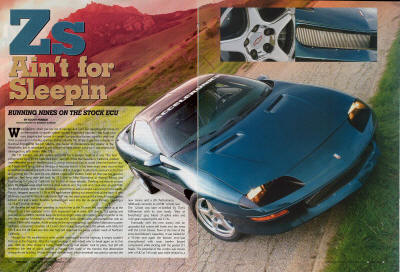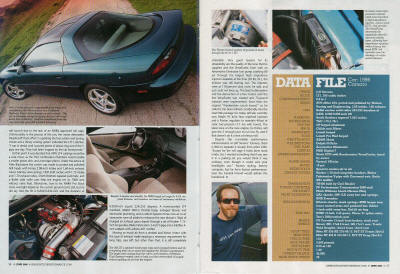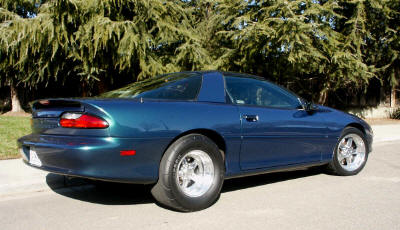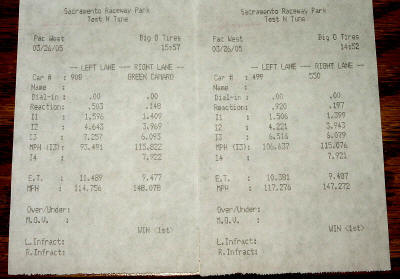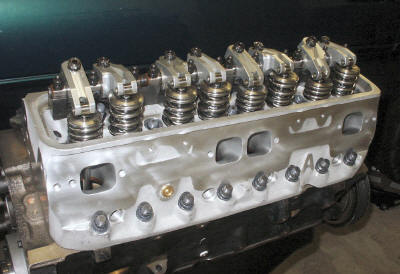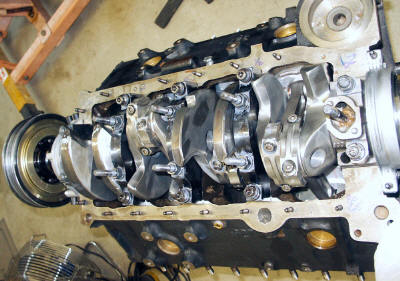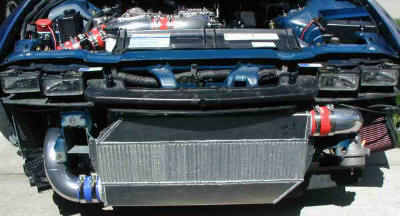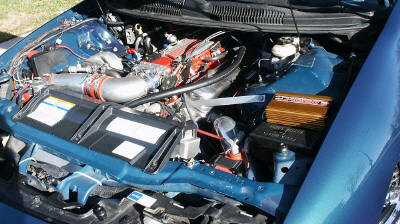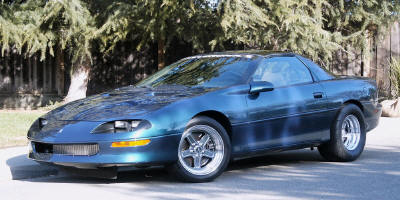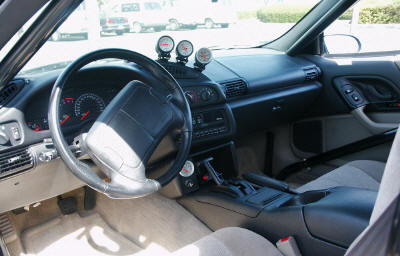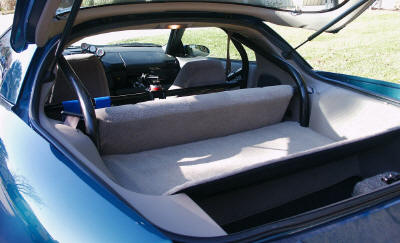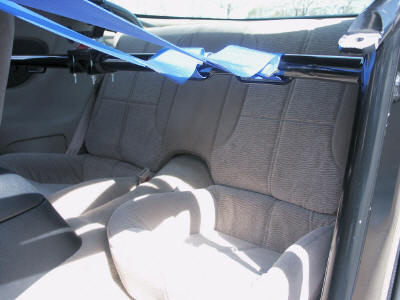10 Year Camaro Project
|
A new job in Silicon Valley motivated the sale of the Monza because, I joked, I would be shot at the California border for trying to bring such a highly modified car into the state. There ensued another lengthy period of uninspiring vehicles. Some of them, such as the Mazda MX6 and Volvo 850, were turbocharged and thus relatively quick compared to their contemporaries. But they engendered no passion. It seemed as though I had outgrown my fascination with genuinely powerful cars. |
Wrong! A lunchtime ride in a coworker's V8 '94 Camaro brought it all back! That V8 rumble alone was enough to start my hunting for my second Z28 Camaro. I tinkered with that car for 10 years, slowly transforming it from tame, showroom floor condition to a wild beast that could accelerate to 150 mph in less than 10 seconds. One national enthusiast magazine, GM High Tech Performance, did a feature story on the car. |
|
Given that I now average at least 8 hours a day in front of a computer with a lightning fast Internet connection, it's almost hard to remember back to the days before ubiquitous email and the World Wide Web. When I bought this Camaro in '96, however, email was just a work communication tool and my home pc didn't have a modem. One fateful day during the lunch hour, I spent a few minutes looking to see if there was any Camaro-related information on the Internet. My first discovery was a Usenet news group called something like alt.camaro-firebird. Wow, look at all the information! It was time for a home modem, and that eventually led to finding an email communication network that enabled daily chatter with other Camaro and Firebird enthusiasts spread across the country. One of the email group benefits was buying power. A member would decide to purchase a part with the hope that it would improve his car's performance. (Note: group posts (emails) from females were extremely rare.) The member would canvas the group looking for other people interested in the same part. If successful, this led to the Group Purchase (gp), which enabled participants to buy the part at a substantial discount. |
The watershed moment in my Camaro's history was the supercharger system gp, which offered the potential for a massive horsepower increase at a price that was $1000 lower than the cheapest retailer I could find at the time. Resistance was futile! The next 8 years saw many iterations of increase power, break something, find stronger parts, repeat. The pieces of paper on the right are time slips from Sacramento Raceway Park showing speed and elapsed time at five points along the 1/4 mile long race track. I1 is 60 feet from the starting line, I2 is at 330 feet, I3 is 660 feet (1/8 mile point), I4 is 1000 feet, and I5 is the finish line. What the time slips demonstrate is that the car would reach 115 mph from a standing start in 6 seconds and 148 mph in 9-1/2 seconds. I always likened my Camaro to a personal roller coaster ride. Friends called it the Green Monster, a name taken from the jet cars built by Art Arfons several decades ago. The name resonated because I was already reading car magazines when Art Arfons and Craig Breedlove were actively chasing the "fastest wheeled vehicle on earth" title. |
|
I've noticed that my embedded video player sometimes cuts of the last few seconds of the following videos.. You should see the elapsed time and speed displayed at the end of the first video. Click here for an excellent video of the car running 9.5 sec at 144 mph at the drag strip. (Note: 5.4 MB .mpg file) Click here for video of me heating the tires before a run at the track. Impressive smoke velocity! (Note: 2.1 MB .mpg file) Come along for a ride on a 9.9 second run. See horizon and trees disappear as front wheels leave ground. (Note: 2.3 MB .mpg file) |
Back in the previous century I started a web site describing many of the modifications as well as the significant part failures. The site is biased towards technical details, including pictures of things such as rebuilding the 6-speed transmission in my garage. I also was an active member of an online discussion group focused on tuning the engine control computer for better performance. Since many questions involving basic concepts came up repeatedly, I decided to write a tutorial covering what I had learned about computer engine control. Click here to visit the main Camaro web site. Click here to go directly to the engine control computer tutorial page. |
|
Since my Camaro site has so many pictures, I'm only presenting a few of my favorites on this page. Let's start out with some sexy (for a gearhead) engine components. While I did not dyno this engine, horsepower estimators using the car's drag strip terminal speed of 148 mph and race weight of about 3850 pounds (including me) calculate the power to be a little above 1000 hp. Fellow Camaro owner Allen Woolley used to joke that the car had ceased to be a Chevrolet because I had replaced or modified just about everything. |
|
At the track I ran large racing slicks on the back and skinny, light weight tires on the front, which resulted in an unusual stance. My search for traction also led to a pair of big tires on the back for normal street driving as well. I ended up with custom Bogart wheels because I could not find any matching sets that combined a 15" diameter rear wheel (to fit the tires) with a 17" diameter front wheel (to clear to brakes). That black knob you see in the right tail light is the battery cutoff switch required by the track because I relocated the battery to the trunk. I could install and remove it in seconds, and the hole in the lens was not noticeable unless you were looking for it. |
|
The interior had many subtle changes as well as a few that were a bit more noticeable. The NHRA-legal roll cage fell into the noticeable bucket once you were inside, but it was not immediately obvious to the casual outside observer. That was intentional - over the years I did my best to support the performance capability of the car while at the same time keeping its appearance more-or-less ordinary. As an example, I spent an entire weekend fitting the aftermarket automatic transmission shift into the console opening. |
Lots of measuring, trial fitting, judicious metal removal, and relocation of factory components. But it fit, I could get to all the gears, and I didn't bash my hand on the console putting it into Park. Then there was relocating the lighter so I could add a transmission temperature gauge.. And adding several switches in the ash tray to control the cooling fans and line lock. Not to mention rewiring the rear window defroster switch to operate my data acquisition system. Etc. :-) |
|
I don't especially miss the Camaro, but I am quite happy and satisfied to have built and driven it. A 9 second car that could be driven to work fairly often (and I did!) is extremely unusual machine that requires persistence, problem solving skills, and a fair dose of optimism that everything will turn out alright. And it did. Buyer Ray drove a long-bed, crew-cab, dually pickup towing a goose neck construction equipment trailer all the way from Alabama to the Sacramento drag strip to watch the car run, then give me a check so he could trailer it home. |
By then time I sold it, the Camaro was chock-full of well engineered parts that resulted in exceptionally consistent performance at the track. If you enjoy that first long, steep hill on the roller coaster, you would love this car! |
